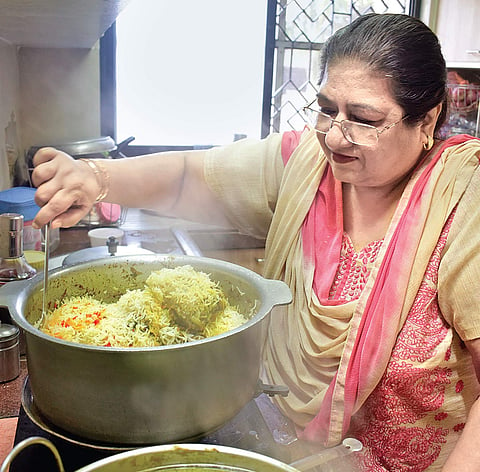

CHENNAI: The holy month of Ramadan is auspicious for all our Muslim friends. While they observe their fast, the non-Muslims count on them for sumptuous Iftar delicacies through this entire month. Lip-smacking kheema samosas, creamy haleem, spicy kebabs, nutritious porridges and sheer korma are staples. Every sub-sect of the Muslim community have their own distinct heirloom recipes and traditional methods of preparation. But, the biryani is what brings them together. CE takes a look at the Mughal dum biryani made by a small community of Ismaili Khojas in the city. Giving this Ramzan speciality a healthy spin, two city-based chefs share recipes with alternatives to rice.
Iftar indulgence
The smoky fragrance of dum-cooked biryani, spicy prawn roast and burnt brinjal curry from Dilshad Munir’s kitchen wafts through the air. This is probably Dilshad’s first at cooking a meal for a small number of people. Born in a joint family with five siblings and 16 cousins, every day was an Eid celebration at her ancestral house in Kilpauk with 50-60 family members.
“We come from the Kutch region and belong to a caste called Ismaili Khojas. I was raised in Chennai. My father, Hasan Ali Dhala was a foodie and a people’s person. He was the first to bring the concept of takeaway biryani to Chennai by starting the Great Moghul Briyani shop at Kilpauk in 1983. As part of our business, we prepared biryani at our own home every day. Hundreds of packets used to get delivered. All the women were involved in the kitchen. Eventually, we moved to a bungalow and started doing the business on a larger scale. The shop is now at Palavakkam and managed by my father’s partner after his demise. Now you find Mughal biryani in every nook and corner of the city,” says the MA Social Science graduate and fashion designer.
Long-lost recipes
Dilshad learned cooking from her mother-in-law Mehru Nissah Esmail and her aunt Mariam Bai. From her first half-boiled biryani — 20 years back — to the perfectly-cooked dum biryani now, she has mastered the art with time. “My mother had a telescopic vision. Her kheema (minced meat gravy) and steak with pepper sauce were delicious. I’ve been cooking for 40 years now,” says Dilshad, a resident of Kilpauk and a mother of two girls.
Ismaili Muslims are a culturally diverse community living in many countries around the world. The community is close-knit and they are spread across Kutch, Mumbai, Hyderabad, and Gujarat. They’re known for hosting lavish meals over weekends and for special occasions. Their cuisine is lesser-known.
Of the many heirloom recipes, Dilshad’s favourites are muthiya and gosht ki khadi. Muthiya is made using bajra and grated coconut. The dish is cooked with mutton, broth and vegetables like long bean and drumstick. This staple is said to be nutritious.
What sets Khoja cooking apart from other Mughal cuisines is its special hara masala made of ginger, garlic, coriander leaves, oil and green chilli paste. It is used in almost every item they prepare. “There are influences of Lucknowi and Gujarati flavours in our food with subtle differences,” she says.
Fast before feast
The community has a separate mosque in Mannady. Both men and women are allowed and are seated separately. “Hijab is not compulsory for us. We fast for 30 days. There are three important days in our calendar — Navroz (New Year) on March 21, Salgirah (birthday of our spiritual guide Aga Khan) on December 13 and Eid. We have roughly 400 members who gather to celebrate these occasions with dandiya dance, food and fun,” says Dilshad.
Every Eid, in the morning, the ladies of the house wake up and begin the festive preparation with sheer korma (a kheer made of vermicelli). The men go to the mosque for prayers, after which, a feast is prepared for family members to savour. “Around 60 people are invited. We have lunch at our parents’ place and invite the guests for dinner. There’s an abundance of food and joy. The much-awaited part is always Eid gifts. My grandfather used to slip in a new `1 note into an envelope and gift us. Fifty years back that was a big amount. We used to get blessings from the elders. Now we do the same for our grandchildren. Traditional practices never change,” she says.
All things feast-worthy
“I lived in Mumbai for a few years after marriage. My neighbours and extended family members eagerly looked forward to Ramzan. The whole building was invited for lunch. My husband’s friends from all parts of the city used to come home. Apart from non-vegetarian delicacies, khichdi is also a popular dish. The delicacy is prepared with green moong dal, broken rice, dollops of ghee and garnished with cumin seeds. It goes well with curd and pickle,” she says.
But, nothing beats biryani. Dilshad’s biryani has a touch of smoky flavours from Mumbai, Hyderabad and Delhi’s schools of cooking. The beauty of the rice spreads in two layers — the relatively plain one that needs to be mixed with underlying spicy one to get a mouthful. Mutton is the preferred option for meat. The essence of it is absorbed deeply and the pieces are tender and succulent. The rice is paired with freshly cut vegetable salad. Instead of eggs, fried potatoes are added. A generous sprinkle of roasted almonds, cashews and dry grapes completes the dish. Caramalised onions are also used to garnish the salad.
“The Eid feast usually comprises mutton samosas, prawn or chicken curry, a roast and qubani-ka-meetha. Our cuisine is an exotic mix of culinary styles. Cooking and eating run in our genes. Our festivals believe in bringing food and community together.”